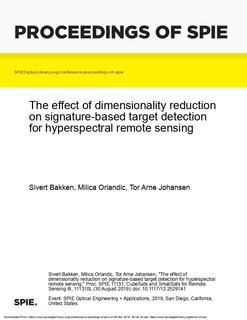| dc.contributor.author | Bakken, Sivert | |
| dc.contributor.author | Orlandic, Milica | |
| dc.contributor.author | Johansen, Tor Arne | |
| dc.date.accessioned | 2019-11-26T12:11:16Z | |
| dc.date.available | 2019-11-26T12:11:16Z | |
| dc.date.created | 2019-11-23T12:56:03Z | |
| dc.date.issued | 2019 | |
| dc.identifier.issn | 0277-786X | |
| dc.identifier.uri | http://hdl.handle.net/11250/2630511 | |
| dc.description.abstract | Target detection is one of the more popular applications of hyperspectral remote sensing. To enhance the detection rate, it is common to do preprocessing to reduce the effects of noise and other forms of undesired interference with the observed spectral signatures. In current earth observing systems, in particular small satellite systems, data rate limitations can make the utilization of sensors with high spectral dimensionality undesirable and even unobtainable. In this paper, the effect of different methods for dimensionality reduction and noise removal has been observed on multiple classical methods for signature matched target detection often used in hyperspectral imaging. The dimensionality reduction differs from resampling in the sense that the original spectral range and resolution can be restored via a linear transformation. This paper suggests that by combining dimensionality reduction and target detection, the resulting data cube has a reduced dimensionality and suppressed undesired effects. The ability to correctly detect spectral phenomena has improved while also achieving reduce data volume. Combining dimensionality reduction and target detection can also reduce the number of computational operations needed in later stages of processing, when operating on the projected space. The observed effects are demonstrated by using simulated and real-world hyperspectral scenes. The real-world scenes are from well-calibrated sensors e.g. AVIRIS, ROSIS, and Hyperion, of classified agricultural and urban areas. The simulated scene is generated using the ASTER library. | nb_NO |
| dc.language.iso | eng | nb_NO |
| dc.publisher | Society of Photo-optical Instrumentation Engineers (SPIE) | nb_NO |
| dc.title | The effect of dimensionality reduction on signature-based target detection for hyperspectral imaging | nb_NO |
| dc.type | Journal article | nb_NO |
| dc.type | Peer reviewed | nb_NO |
| dc.description.version | publishedVersion | nb_NO |
| dc.source.journal | Proceedings of SPIE, the International Society for Optical Engineering | nb_NO |
| dc.identifier.doi | 10.1117/12.2529141 | |
| dc.identifier.cristin | 1751326 | |
| dc.relation.project | Norges forskningsråd: 270959 | nb_NO |
| dc.relation.project | Norges forskningsråd: 223254 | nb_NO |
| dc.description.localcode | © 2019 Society of Photo Optical Instrumentation Engineers. One print or electronic copy may be made for personal use only. Systematic reproduction and distribution, duplication of any material in this paper for a fee or for commercial purposes, or modification of the content of the paper are prohibited. | nb_NO |
| cristin.unitcode | 194,63,25,0 | |
| cristin.unitcode | 194,63,35,0 | |
| cristin.unitname | Institutt for teknisk kybernetikk | |
| cristin.unitname | Institutt for elektroniske systemer | |
| cristin.ispublished | true | |
| cristin.fulltext | postprint | |
| cristin.qualitycode | 1 | |
